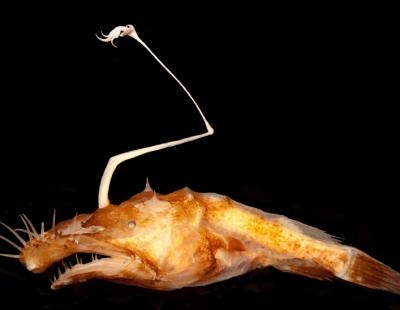

"Watch: World's Deepest Fish Lurks 5 Miles Down in Mariana Trench." National Geographic. "Pacific Barreleye: Fish with a See-through Head." Aug. "Unusual Offshore Octopods: Telescope Octopus Has Totally Tubular Eyes." Scientific American. "The Clear-headed Fish." Scientific American. "What Lives at the Bottom of the Mariana Trench? More Than You Might Think." Scientific American.

"Deep-Sea Hatchetfish." Australian Geographic. "Rare and 'Horrific': Frilled Shark Startles Fishermen in Australia." NPR. "Frilled Shark Caught off Australian Coast." USA Today. They may be our Earth cousins, but considering how little we know about them, they might as well be from another world. So like the trench itself, the animals that live there will continue to be mysteries, too. Still, this underwater canyon is one of the most unexplored places on our planet, and it will likely remain so until we find new ways to peer into the depths without risking being crushed or drowned (or breaking our research budgets). Thanks to better technologies, we humans have finally begun to peer into the blackness of the Mariana Trench. The female releases her fertilized eggs into the water, the worm's lifecycle begins anew, and the zombie worms go about their business of cleaning up whale debris in the ocean's darkest corners. Eventually, the males find their way into the female's oviducts. The males are microscopic by comparison, and females will collect a male harem of these tiny guys on their bodies. Its feathery "branches" wiggle in the water, pulling in oxygen to keep the worm alive.įemale zombie worms can grow up to around 2 inches (5 centimeters) long. Then, it uses symbiotic bacteria to convert the bone's proteins and fats into nutrients that serve as its food. The zombie worm secretes acids to help it access the inner contents of those dead whale bones. But this worm also goes by fiercer monikers such as bone worm or zombie worm, and it can consume the rock-hard bones of some of Earth's biggest animals, including whales. Officially, it's called the osedax, and its name, as well as its feathery appearance, make it seem like a plant from a Dr. But these species aren't just weird they're also some of toughest animals around. Let's shine a dim ray of sunshine through this watery, mysterious underworld and peek at a few of the most bizarre living things on the planet. Fittingly, some of these critters are wonderfully strange. But these expanses are not lifeless.Ī few manned and unmanned vehicles have parted the waters of the trench in recent years, proving that there are indeed organisms living and even thriving in this nearly alien environment. This particular area of the sea, then, is more than a little inhospitable. The pressure is so high that it will crush nearly any creature (or manmade object), unless that animal or vessel is built specifically to withstand those extremes.

The water pressure in the trench is nearly 1,000 times greater than at sea level. Water temperatures often settle in at just above freezing. If you plunge deeper than 3,280 feet (1,000 meters) into the ocean, there's no sunlight to spawn life. It's a place so foreign that until recent decades, scientists had almost no clue as to what - if any - sort of lifeforms might be hovering there. As the plates collide in slow motion, the edges push downward into a V shape, creating a valley that has no equal on our planet. The trench forms where two tectonic plates (jigsaw-puzzle-shaped pieces of Earth's crust) crunch into each other.


 0 kommentar(er)
0 kommentar(er)
